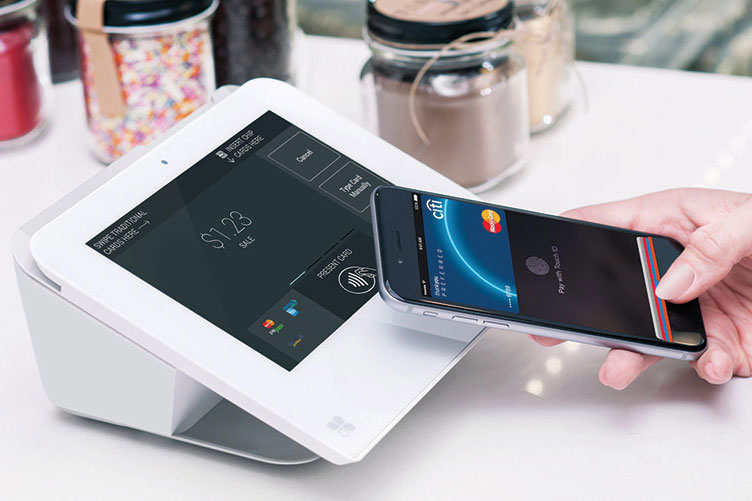How secure are NFC payments?
Editorial Team
5 min read
Paying for products and services hasn’t always been as easy as waving our phones at payment terminals. Near field communication (NFC) technology is one the the most innovative payment technologies to emerge in the last two decades, and it has big advantages for businesses of any size. If your business accepts payments via GooglePay® or Apple Pay®, you may already be processing NFC transactions without knowing much about it at all.
NFC allows devices in close proximity to one another to wirelessly transfer data back and forth. The technology is very similar to Bluetooth®, but NFC uses far less power and works over much shorter distances. In the last few years, contactless payments have become more mainstream, with more and more businesses adding in-store NFC readers.
Now all you have to do is wave a mobile phone, credit card, or wearable smart device to authorize a transaction. So how exactly does NFC technology work, and how secure is it?
What is NFC, and how did we get here?
These days, creating a contactless payment experience is really simple. Mobile NFC payments are made via smart phones and other smart devices. First, users upload their credit card details into a mobile payment app on their phone. Their card details are then encrypted within the phone and can then be used to generate one-time authorization tokens for individual purchases.
When a customer is ready to make a purchase, they unlock their phone using a pattern, password, fingerprint scan, or facial recognition (like Face ID). Next, they wave their device across a payment terminal to initiate a connection (an electromagnetic induction link) between the phone and the reader. This link authorizes a transaction. And voilà–you’ve made a sale.
NFC technology had a rough start, with many promising solutions struggling to break into the market. Despite leveraging many of the most up-to-date security features available at the time, Google Wallet, for instance, didn’t win over enough converts to succeed because it favored Android devices and was only available on specific NFC-enabled Androids. The release of Apple Pay in September 2014 proved a turning point, however. Apple managed to boost NFC’s popularity by securing advanced agreements from hundreds of thousands of merchants. Apple’s iPhone® 6 and iPhone® 6 Plus, which were released that year, became the first Apple Pay-enabled phones.
While it took time for NFC payments to gather momentum, growth in these transactions has been enormous and is predicted to continue. The global mobile payment market was valued at $3.84 trillion in 2024 and is expected to grow to $27.81 trillion by 2032. NFC transactions are lauded for their convenience, versatility, ease of use, and security.
A closer look at mobile NFC payment security
While NFC technology provides a very high level of security thanks to its small communication range and encryption capabilities. Here’s a look at the top security features that help prevent unauthorized parties from accessing financial data transmitted in NFC transactions:
1. User initiation
In order to begin any NFC transaction, the customer must actively initiate the contactless payment process. This usually requires launching the appropriate NFC application within the phone in order to establish a connection between the device and the merchant’s reader. In other words, no transactions can happen in standby mode. Users must choose what information to share and not to share. With some NFC applications, the user can also opt to verify a transaction using two-factor authentication, like fingerprint scanning technology or an additional pass code.
2. Encryption and Tokenization
All data transmitted between an NFC-enabled device, like a smart phone and the payment terminal, is encrypted. By converting the information into a secure code, unauthorized parties are prevented from intercepting private information such as transaction amounts and credit card numbers.
Many NFC payment systems also rely on tokenization. Rather than transmitting a credit card number, a unique digital token (aka tokenization) is created to represent this information for each individual transaction. Even if intercepted, tokens can’t be used in any way in a future transaction.
3. Proximity protection
Contactless payment solutions work over incredibly short distances (we’re talking about centimeters–not feet). In order for would-be thieves to steal information, they would have to stand uncomfortably close to an NFC-enabled device. This proximity protection represents a basic line of defense.
4. Secure element validation
Once a connection has been established, the transaction only goes through after the NFC-enabled device has validated the purchase using a secure element chip. This validation process assigns a unique digital signature to every payment instead of transferring credit or debit card numbers between the device and reader. Secure element chips are also separated from the smartphone’s main operating system.
NFC payments are secure–but are they foolproof?
With multiple layers of protection, NFC technology is one of the most secure payment options currently available. Of course, no payment technology is completely foolproof–not even cash. For example, a stolen device could be used to make contactless payments without a customer’s authorization. Data tampering, eavesdropping, phone malware, and NFC tag cloning are also potential concerns.
However, there are steps you can take to help protect your private financial data:
- As a consumer, make sure to password-protect your mobile device. If your smartphone falls into the wrong hands and is password protected, thieves will have a much harder time initiating payments without authorization. You can add another layer of security by setting up two-step verification for NFC keys and on credit and debit cards.
- As a merchant, you can make your payment infrastructure more secure by ensuring that your credit card processing remains PCI-compliant and follows the latest industry guidelines.
Interested in learning more?
With a Clover POS system, your business can offer your customers secure contactless NFC payments and accept just about any type of traditional payment–from cash and checks to debit cards and gift cards. What’s more, a Clover POS system designed especially for your business, offers you integrated solutions and a whole market of partner apps to make daily operations even simpler–think employee management, inventory management, reporting, and even sales tax payments. Learn more about how Clover can empower your business to accept almost any type of payment and securely and quickly.
Related Posts
Are you controlling for these 10 small business risks?
8 effective hiring strategies and best practices to help you deal with the labor market this holiday season
Popular Topics
Stay in touch
Sign up and learn more about Clover.
Thank you for your subscription!
More posts about starting a small business
eBook





